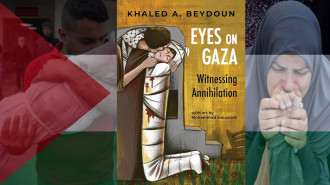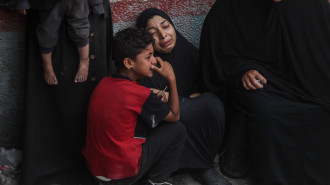

For the international art community, whether in Dubai, Paris, or Seoul, the post-summer "back to work" mode was in full swing, with art fairs taking place and galleries putting on their best shows for the new art season.
Among the wide roster of events that happened was a unique annual exhibition — Menart Fair — in the French capital, devoted entirely to placing a spotlight on contemporary and modern artists from the Middle East and North Africa.
Running from September 20 to 22, the fifth iteration of the fair, founded in 2021 by Laure d'Hauteville, shook things up by showcasing artworks, including paintings, sculptures, photography, and installation pieces, made exclusively by female artists from across the Middle East.
This decision, featuring approximately 80 women artists, marked a first for a major art fair. "This year, we wanted to show the public that, before being 'women,' they are artists," read a statement published in Menart's catalogue. "They have their own ways of dealing with identity and autonomy, the body and sexuality, their everyday experiences, social and political justice."
Here were six standout female artists who participated in Menart, showcasing a variety of artworks that addressed the personal, the playful, and the political.
Farideh Lashai
Considered one of 20th-century Iran's pioneering artists, Farideh Lashai was born in 1944 and led a career that lasted for more than five decades. She studied German literature in Frankfurt, Germany, and glass design in Vienna, Austria, where she worked as a crystal designer. However, Lashai, who passed away in 2013, is mostly remembered for her delicate yet, at times, brutal abstract paintings, which are greatly inspired by nature.
A decade ago, the Farideh Lashai Foundation was established to honour the artist's legacy and participated in Menart by showcasing a painting from 2008 that features feminine pink and orange hues.
Katya Traboulsi
Known for her colourfully adorned war bomb shell pieces, the Beirut-born multidisciplinary artist Katya Traboulsi presented a vibrant wall-based installation at the fair.
Entitled Kamar Al Zaman (2022), the hand-painted artwork was made of iron and was meant to resemble the backs and fronts of Lebanese pick-up trucks.
Exploring Arabic typography and contrasting notions of love and superstition, the artist dotted the playful piece with common Lebanese and Arabic sayings, eye symbols, floral gilds, and other forms of ornamentation.
Alaa Ayman
In her small blue-and-white painting entitled As I Was Moving Ahead Occasionally I Saw Brief Glimpses of Beauty (2023), the Egyptian painter Alaa Ayman captured a tender moment of a kissing couple.
Executed with loose brushstrokes, Alaa was inspired by the 2000 film of the same title, which features private home movies of family and friends shot by the avant-garde Lithuanian director Jonas Mekas. "I tried to provide a narrative of memories from different people and different times, but still they connected with each other through the same feeling," Alaa explained on her Instagram account.
Nazgol Ansarinia
The Iranian-born artist Nazgol Ansarinia is showcasing a thought-provoking sculptural piece from her Pillars series, created in 2014.
It represents a column cast in resin, with the base partially sliced open to reveal an economic article from the Iranian constitution.
According to the fair, "Her work explores the systems and networks that underpin her life, dissecting and interrogating objects and events to tease out their relationship with contemporary Iranian society. By picking apart and reassembling these elements, she exposes the collective assumptions and inherent rules of a social system."
Fatimah Al Nemer
Originally a jewellery designer from Saudi Arabia, Fatimah Al Nemer used her mixed media art to explore themes of women, traditions, and social folklore.
Often depicted on carpets, veiled women posed in traditional attire while holding local props (which sometimes covered their mouths) amidst a visually stimulating scenography of Arabic writing and detailed ornamentation.
Laila Shawa
Born in Gaza in 1940, the late Laila Shawa was a prominent Palestinian artist and teacher whose works predominantly delved into the topics of war, occupation, and identity.
"Through her paintings, photographs, and installations, Shawa explores the complex realities of Palestinian life and critiques power and gender dynamics," according to Menart's catalogue.
At the fair, a striking work of Shawa's came from her 1994 series Walls of Gaza II, showing politically charged graffiti written on the walls of her hometown. The works, notably injected with brightly coloured interventions, were based on the artist's photography, later transformed using silkscreen printing techniques.
Rawaa Talass is a freelance journalist focusing on art and culture emerging from the Middle East. Her work has been published in Art Dubai, Arab News, Al Arabiya English, Artsy, The Art Newspaper, Kayhan Life, Dubai Collection, and The National
Follow her on X: @byrawaatalass









 Follow the Middle East's top stories in English at The New Arab on Google News
Follow the Middle East's top stories in English at The New Arab on Google News


